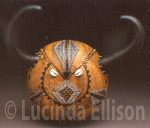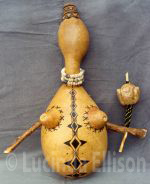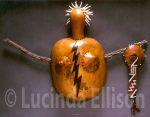
 |
|---|
|
|
|
Thumb Pianos |
|||||||||||||
Artifact |
The Thumb Piano, or Mbira, is an instrument of African invention. It's often called a “Kalimba”, however this name is a registered trademark, and though it is now a generic name, it is a relatively new term for only one type of thumb piano in a large family of instruments called Lamellaphones, that originated all across Africa centuries ago. The Kalimba® name was coined by Hugh Tracey in the early 60's as his name (meaning “little music”) for his design of a thumb piano modeled after the originals that he had studied since the 1930's. Known traditionally as Mbira, Sansa, Likembe, Agidibo...(it has as many names as there are language groups on the continent!), it has no equivalent in the Western world, though the marimba and xylophone are its direct descendants. For centuries throughout Africa, it has been played by master virtuosos and little kids alike, either for ceremonies (Zimbabwe, Mozambique), music ensembles (Nigeria, Zaire), or to simply pass the time on a long walk (Kenya, Zambia, Botswana). |
|||||||||||||
In Zimbabwe the mbira dzavadzimu is used by the Shona people to contact the ancestors and tribal guardians in ceremonies called “bira”, and is an essential like between the world of the living and the world of the spirits. Recently, the term "mbira" has come to replace "thumb piano" as the more traditional-sounding generic term for the many styles of thumb pianos and plucked idiophones of the world. Today my instruments are used by professional studio and touring musicians, in schools, by storytellers, by music and sound therapy practitioners, art collectors, gourd enthusiasts, and people from all walks of life who enjoy the beautiful, relaxing qualities of the mbira. My acoustic mbiras have a soundboard, made with traditional African or native American hardwoods, which is mounted on a dried gourd, hand picked to be sure that its contour and hardness make it an ideal resonating chamber. The character and shape of the gourd gives each thumb piano its own sound and feel. The playing tines, keys, are made from durable nickel plated steel. |
Quilted Maple Vase |
|||||||||||||
I enjoy working with the pattern and movement in the hardwoods and combining these with the sensual, exotic shapes of the gourds. The simple yet evocative beauty of the music is enhanced by the strong decorative design elements I incorporate. The mbira has a quiet soothing sound, and with practice the number of songs that can be played is infinite; you can play familiar melodies and rhythms, or improvise your own. Anyone can pick up this instrument and make harmonious sounds and feel like a pro in no time. |
||||||||||||||
Acoustic Thumb Pianos Necklaces Percussion *some pieces not available for this sale; please inquire |
Quilted Maple |
Playing the Mbira |
||||||||||||
|
Sculpted Turtle |
|||||||||||||
Two Chi-Wara |
||||||||||||||
- Joe Bender, Master Drum builder, Village Drum |
||||||||||||||
“Having had the joy and pleasure of using Lucinda’s wonderful instruments, played by the maker herself, in my concerts of Harmonic Chant all over the US, what more can I say? Lucinda’s Embira™s are among the finest, most lovingly-made instruments around.” - David Hykes, Founder-Composer, The Harmonic Chant |
||||||||||||||
Current Inventory and Pricing |
||||||||||||||
| Turquoise Lotus |
||||||||||||||
| Goddess Temple |
||||||||||||||
Sculpture/Wall Pieces |
||||||||||||||
 |
 |
 |
||||||||||||
Occasionally I will do a few pieces that are more decorative than functional, though each will have some sort of musical sound that it may create. The Mask on the left has an Mbira on its reverse side; Osage Queen is holding a functional gourd rattle, and Amazon has a shield/rattle which is also removeable. Please click on Isis, on the far right, for her description. |
||||||||||||||
Home | Lucinda | News and Events | Contact
© 2002-2014 Lucinda Ellison. All rights reserved Worldwide.
Web Development by Nu Essence Design, LLC